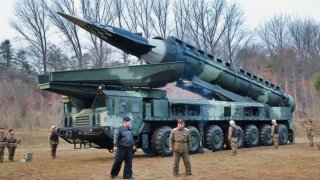Did North Korea Really Test a Hypersonic Missile?
North Korea is working toward the deployment of hypersonic missiles that it claims could render South Korean and U.S. missile defenses useless. Still, its claims of a successful test this month appear greatly exaggerated
North Korea is working toward the deployment of hypersonic missiles that it claims could render South Korean and U.S. missile defenses useless. Still, its claims of a successful test this month appear greatly exaggerated.
An advanced, fully developed hypersonic missile could allow the North to pose a serious threat against South Korea. Such a missile could fly very fast, very low, maneuver to counter defenses, and accurately hit its targets, potentially defeating South Korean and U.S. missile defenses and making targets in South Korea vulnerable. North Korea’s bluster about its test is clearly aimed at creating an environment of fear in South Korea and elsewhere.
On April 2, North Korea launched what it claimed was an intermediate-range missile equipped with a “newly-developed hypersonic gliding flight warhead.” North Korean state media announced that “the hypersonic glide warhead reached its first peak at a height of 101.1 kilometers and the second at 72.3 kilometers while making a 1,000-km-long flight as planned to accurately hit waters in the East Sea.”
While South Korea, Japan, and the United States don’t reveal their full technical findings on missile tests, the South Korean Joint Chiefs of Staff (JCS) showed that this North Korean missile is still early in development and thus is not currently a serious threat. Consider this evidence.
The JCS said the missile launch was designed to test its ability to fly. The missile did fly, though neither as far as an intermediate range (3,000 to 5,500 km) nor to the exaggerated North Korean claim of 1,000 km—it only went 600 to 650 km, according to South Korea and Japan. So, was the North Korean flight at least a partial failure, if not a significant one, or was it a partial test with limited fuel? The North claimed that it “…intentionally delayed the ignition of the missile’s second-stage engine and changed the direction of flight.” However, the South Korean JCS says the intentional ignition delay was also an exaggeration.
The North’s claims that this missile would be difficult to track are also questionable. The South Korean JCS said they immediately detected the missile launch and traced its path, sharing information with the United States and Japan. And a missile flying at 100 or even seventy kilometers altitude would be relatively easy to see. Did the missile descend to a low altitude (100 meters or so) where a missile defense radar would have more difficulty seeing it?
Because the flight was over the ocean, this glide vehicle was unable to test terrain matching, which could be required for the missile to be accurate and to help it stay close to the ground to hide it from a missile defense radar. Did the missile maneuver to complicate interception? The missile may not have these capabilities, and without them, it is not much of a threat. If it does have them, they apparently still need to be tested.
Did it really fly at hypersonic speed? The glide vehicle reportedly flew 650 km or so in about twelve minutes, suggesting an average speed of less than Mach 3, well below hypersonic speed, defined as Mach 5 or higher. Flying at hypersonic speed at low altitudes in the atmosphere requires very advanced materials to prevent the glide vehicle from burning up; it may well be that this North Korean glide vehicle still lacks such materials.
Even if all of these issues are resolved in North Korea’s favor, are the Patriot missile defense systems unable to intercept a hypersonic missile? While the Patriot does not appear to have been tested against glide vehicles, it has been tested in Ukraine against the Russian Kinzhal hypersonic missile. While there are Ukrainian versus Russian debates about how many Kinzhals Patriots were shot down, at the very least, Patriots were successful in defending against Kinzhals on several occasions.
So, when one considers all of these issues, it seems highly unlikely that the newly tested North Korean hypersonic glide vehicle will pose a real threat anytime soon. If North Korea wants this weapon to spark fear in the South, it would need to successfully fly it in the atmosphere at speeds greater than Mach 5, maneuver it without causing it to burn up, fly it very low over land with hills and valleys, and prove its ability to hit targets (not broad ocean areas) accurately. Deficits in these areas could leave Patriot defenses able to intercept it. By the time North Korea can deploy a more capable hypersonic missile, the United States may well have fielded an advanced defense system capable of dealing with it.
While North Korea’s recent test flight failed to establish hypersonic missiles as the latest addition to its arsenal of threats, it did demonstrate that the regime of Supreme Leader Kim Jong-un remains deeply engaged in the pursuit of new tools of intimidation and coercion.
About the Author. Dr. Bruce W. Bennett
Bruce W. Bennett is a senior international/defense researcher at the nonprofit, nonpartisan RAND Corporation. He works primarily on research topics such as strategy, force planning, and counterproliferation within the RAND International Security and Defense Policy Center.
Image: KCNA/Screengrab.


